Table of Contents
Setting up a knockout
Here we are going to set up a brand new knockout event and walk through what organisers need to do to get themselves up and running. You will need to be logged on as a club, district or county.
Create a knockout
In the EBUKnockout area you will find a button to Create New Knockout. Pressing this will open up the following screen.
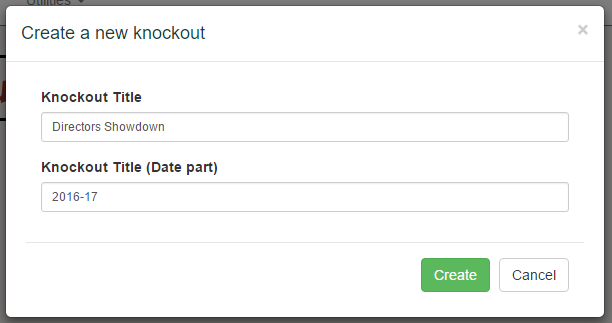
The Knockout Title is split into two parts: the name of the event and the date. This makes it easier to group similar knockouts together on the results pages.
Important: if you are creating a new Plate event based on an existing Main event, please see the Setting up a Plate event page. This links the two events together and makes it easy to copy teams from one event to the other.
List of knockouts

The knockout will now appear in your list. Click on it to open up the knockout page. Here you will see all the information about the knockout in one screen. At the top there is round information, and links that let you draw a round. Then there is the match list, which shows you all the matches and gives you options to filter and search for teams. And finally, at the bottom, there is the teams list which lets you add, remove and amend teams who are taking part.
Edit knockout settings
The overall knockout settings can be found by clicking on the little notepad icon next to the knockout name. This will open up a form like the following:
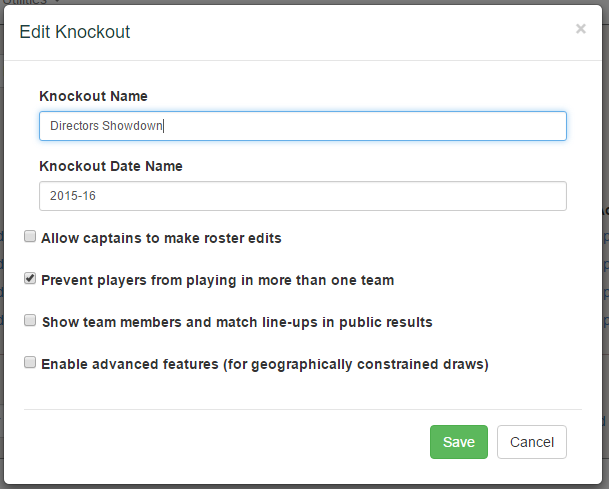
Name and Date Name can be changed here if you change your mind about that.
Allow captains to make roster edits gives captains the ability to change members of their teams themselves. This will lighten the load of the event organiser if the event regulations allow it.
Prevent players from playing in more than one team will check any new players being added to see if they are registered on another team. Note that this is not enforced for a Plate event, which is considered to be a separate knockout.
Show team members and match line-ups in public results means that the players in each team will appear in the public results page of the EBU website, along with who played in any particular match.
Enable advanced features switches on some advanced geographical features which you can read more about on its own page. We do not expect anybody other than the EBU itself to use this feature but if a group of counties want to get together to organise a knockout event, there is the option to restrict draws to avoid excessive travelling.
Add teams
The first thing you'll want to do is add all your teams. Your life will be much simpler if you add everyone before you do things like setting up the round structure and drawing the first round. However, those tasks are not final and there are ways of editing the draw if a team does enter your event late.
The simplest way to add a team is to click on the Add team button. This will open the following form:
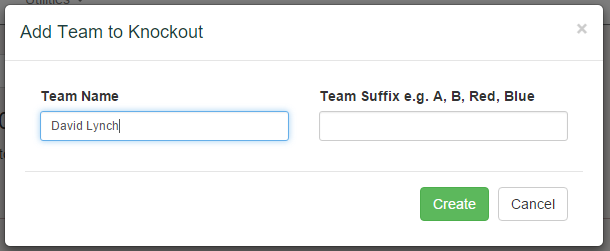
All you need here is the team name - you can make other settings later. The Team Suffix is separate from the team name to make it easier for the draw system. This is where you put the 'A' and 'B' if you have teams like Aylesbury A and Oxfordshire B.
Import CSV of teams
For larger events, you may find it simpler to prepare a CSV file of team information, rather than adding the teams one by one. The required format is as follows:
Aylesbury,A,OXF,HP19 8AZ,00987654,00900001,00900002,00900003,00900004 Aylesbury,B,OXF,HP19 8AZ,00987654,00900005,00900006,00900007,00900008,00900009 Thame,,,,,
The columns are, in strict order:
Team Name (required) Team Suffix Team County Code (3 characters, only really used by the EBU to restrict matches) Home Postcode of team (only used for geographically constrained draws) EBU# of team club (can be used to link a team back to their club) Captain's EBU# Player 2's EBU# Player 3's EBU# etc.
You can only assign one captain via the CSV file, but it is easy to make other players captains once they have been imported. Most of the fields can be blank and you can leave out the players - see the third line in the example above for a minimal record.

Once the file has been prepared, click on the Import CSV of Teams button and drag the file into the box, or browse for it through the Browse button. If the file loads successfully it will tell you how many teams and players have been read and if you're happy with it you can click on Submit.
List of teams

Now that we've added some teams, you should see them listed at the bottom of the page. The teams with black asterisks are the originally seeded teams, and any that have a red asterisk are a team who are seeded by virtue of defeating a seed. To amend a team's information you can click on the team name.
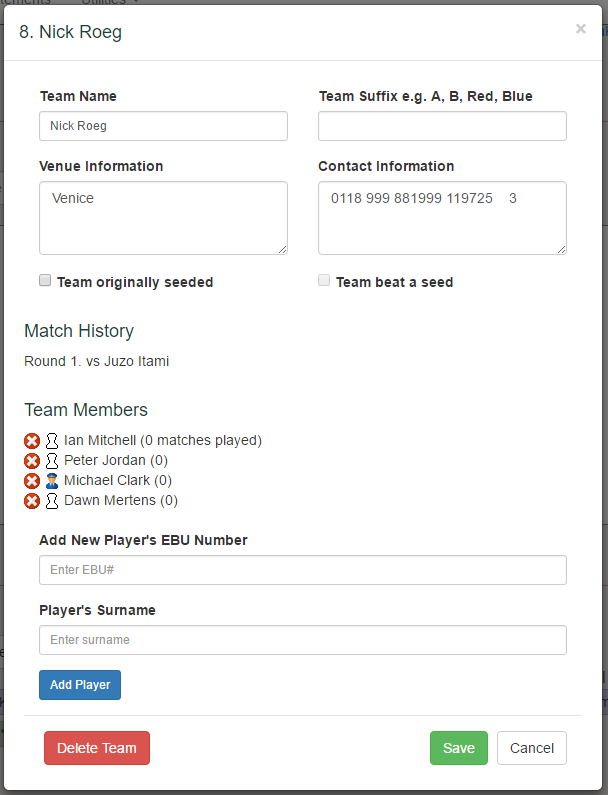
At the top you can change the team name and suffix, if you need to. The Venue Information box would usually be used by the team captains rather than the event organiser. This allows them to enter some information about their home venue, for the benefit of their opposition.
Contact Information can also be seen by the opposition captains and allows the team to tell them how they would like to be contacted. You might, as the organiser, pre-seed this with email addresses or let the captains enter this themselves.
Team originally seeded can be checked to make this team a seed. Note that you cannot check this box after the team has played a match, as it messes up some of the calculations. If you must amend this later, remove the result of any matches the team has played (delete the scores), change the team seeding and then reenter the match results.
Team beat a seed is set by the system if the team defeated a seed. They will be treated as a seed for any future draws.
Below this you will find the Match History and the Team Members list. New members can be added to the team by entering the EBU number and surname in the box and clicking Add Player. You can make someone a captain by clicking on the outlined captain next to their name. Current members can be removed (if they have not played any matches) by clicking on the cross. Note that you must always leave at least one captain on any team.
Finally, you can delete the team by clicking on the Delete Team button.
Set up rounds
To set up the rounds click on the Set Up Rounds button at the top of the page. Important: you will find it much easier to add all of the teams before you set up the rounds. The number of teams you have directly influences the number of rounds and the number of byes and adding teams later will require you to recalculate the event format. Some things to bear in mind:
- Be aware of your powers of 2. In a simple knockout, it's much easier to add the 16th team than the 17th team.
- If you know a team is going to enter but you don't know their name, consider adding a dummy team and changing the name later.
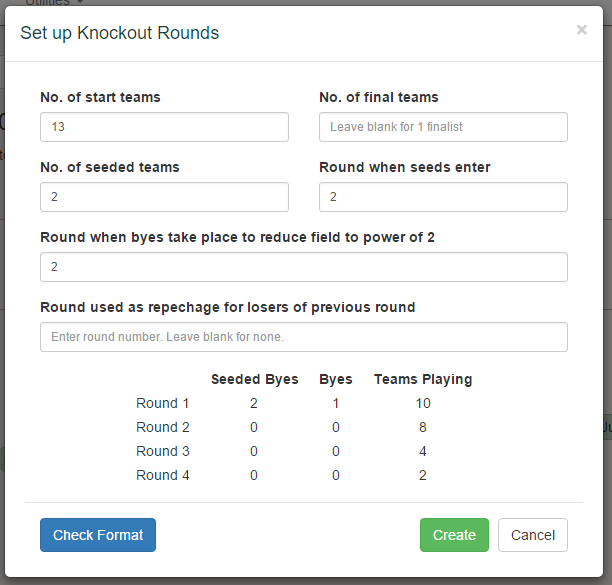
To use this form, fill in the boxes and click Check Format. If the round format that appears looks good to you, you can go ahead and click Create to confirm.
No. of start teams is the total number of teams in the knockout. This includes seeded teams.
No. of final teams is the number of teams you want to come down to. Usually this will be one, but sometimes you will want to qualify a different number to a new event. e.g. Crockford's Cup.
No. of seeded teams is the number of original seeds in the event.
Round when seeds enter is the round when the seeds play their first match. For this purpose, rounds are numbered 1, 2, 3, etc. If you want to give your rounds different names you can do that later.
Round when byes take place to reduce field to power of 2. Unless you have a number of teams equal to an exact power of 2, you will need to add in some byes to get the numbers correct. Often these happen in round 1, but some organisers (like the EBU itself) prefer to play as many first round matches as possible and then add in the byes in round 2.
Round used as a repechage for losers of previous round. Some competitions give first round losers a second chance to proceed, by pairing them off with other losers in a repechage. This field lets you set the round where this happens, although it should really always be set to 2.
Important: the settings in this form cover all of the common set ups, but please check the numbers to make sure they make sense for your specific event. You can tweak the numbers in the round settings later if there is anything wrong.
Edit a round

Once your rounds are set up, you'll see a table like the above. Not everything has been set, though, so you still need to go into each round and add some details. Clicking on the round name, or the notepad icon next to it, will open a form like the following:
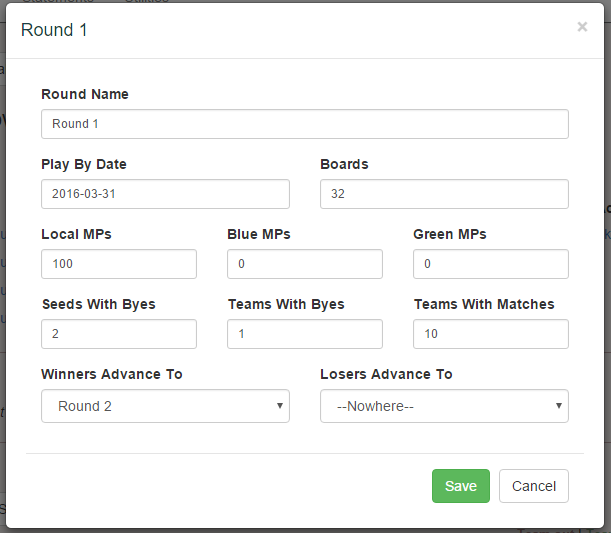
Here you can fill in the following details:
Round Name is self explanatory and you will often want to change this, for example by calling the last round the Final and the penultimate round the Semi-Final.
Play By Date tells team captains when they need to arrange their matches by.
Boards tells team captains how many boards are played in a match. It can also be used to determine whether a team member has played enough boards to be eligible for masterpoints.
Local MPs etc. state how many of each colour of masterpoint are awarded for winning a match in this round. Please consult the Masterpoint Handbook for what the awards should be. Note that Green and Blue points should be multiplied by 100 to get into the same scale as Local points. For example, 1.5 Green Points would be expressed as “150”.
Seeds With Byes, Teams With Byes and Teams With Matches determine how many seeded byes, random byes and teams with matches there are in this round. It's best not to mess with these numbers unless you're confident about what you're doing. If you need to change the knockout format because a team entered late, it's better to use the Amend Rounds form and do the entire event again.
Winners Advance To and Losers Advance To give you manual control over how winners and losers from this round progress in the event. Again, it's better not to mess with this unless you have some unusual requirements.
Make a draw
The next thing you'll want to do is draw Round 1. Instructions on how to do this can be found at Making A Draw, so head over there and then come back here to continue the tutorial.
Entering a result
Clicking on a match in the match list opens up a form like this:
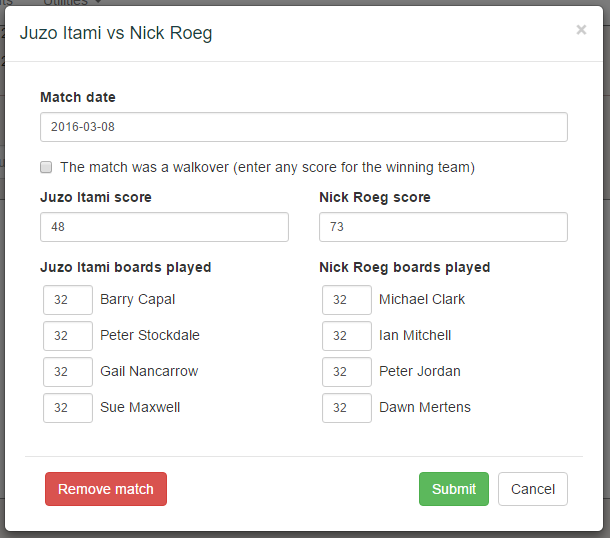
Here you can enter the match date, match score, whether or not it was a walkover (in which case give the winning team any score to indicate which team proceeds) and the number of boards that each player played.
You may find that entering the result of this match updates future matches that the result of this match depends upon. That's all handled automatically, so you don't have to do anything. Note that if the later match already has a result entered, you will not be able to change the winner of this match.
